|
Click photos to
enlarge. |
 |
Summer
Savory |
|
 |
Italian Oregano
origanum x majoricum
A cross of oregano and marjoram. Blends well with basil and
tarragon. Flower color is pink. |
|
 |
Lemon Balm
melissa
officinalis
Lemon scented
with a hint of mint, leaves can be used whole or chopped in a
variety of dishes, including salads, marinades, vegetables,
lamb, and shellfish. Lemon balm can also be used to make a
delicious tea. Flower are yellow or white clusters. |
|
 |
Dill |
Planted 2003 from seed from Roger Hoehensee |
 |
English Lavender
lavandula angustifolia
Not only is
English Lavender a superb fragrant ornamental, but it also
has culinary and medicinal virtues. Flower color is medium
purple. |
Planted 2003 |
 |
Sweet Basil
ocimum basilicum
Rather than being sweet, as the name implies, this herb is
spicy. Very popular for use in pesto. Flowers are edible.
Basil is a member of the mint family |
|
 |
Rosemary
rosmarinus
officinalis
Described as piney, sweet and mint-like, with a finish of
ginger. Combines well with a variety of meats and fish,
rosemary also enhances several vegetables and complements
other herbs. Also excellent in a variety of marinades,
sauces, soups and marinades. Flowers are pale blue
clusters. |
|
 |
Garden Sage
salvia
officinalis
Shooting up to three feet with its blooms, garden sage is
a purple delight Flower color: purple |
|
 |
Purple Sage
Salvia offinalis purpurea
Aromatic, oval
purple foliage is very ornamental. Produces spikes
of blue flowers. Plant in full sun. Grows 18'
tall.
|
Driveway Herb Bed |
 |
Golden Sage
salvia
officinalis icterina
Can be used
in any recipe calling for sage. Fresh leaves make an
attractive garnish for roast chicken or turkey.
Flower color blue. Rarely blooms. |
|
 |
Pineapple Sage
salvia elegans
While pineapple
sage does have a pineappley fragrance, its only real use
in cooking is as a fresh edible flower. The flowers are
reminiscent of honeysuckle and make a colorful addition to
salads, fruit cocktails or any garnish. Their vibrant red
color complements many dishes particularly attractive with
yellow or green bell peppers. Flowers can be sugared and
used to garnish cakes or cookie platters.
Great plant for attracting hummingbirds to the
garden. Flower color: bright red. Tubular shape. |
2005 Plant Exchange |
 |
Berggarten Sage
salvia officinalis
"berggarten'
Dense, compact growth habit with large, aromatic,
gray-green leaves. Use in cooking and for its
decorative effects in the garden. Full sun. |
|
 |
Cuban Oregano
Plectranthus
amboincus
This
aromatic species has fleshy green leaves and a trailing
habit when the branches are allowed to grow long.
Cuban Oregano is a member of the same family as Coleus,
and as such is not a true oregano. It makes a nice
houseplant - especially the variegated type shown above,
and is propagated easily by cuttings. |
Purchased from HyVee
Garden
Center Spring 2005 |
 |
Chives
allium
ochoenoprasum
Tastes like
sweet, mild onions. Minced fresh leaves can be used in
recipes or as garnish. Whole leaves can be tied
decoratively around vegetables. Flowers can be used in
salads, vinegars or as a garnish.
Flower color: pale purple |
 |
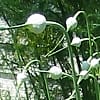 |
Garlic |
Started from seed
fall 2002. Harvest in Summer 2005. |
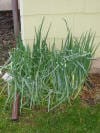 |
Winter Onions |
|
 |
Horseradish
|
|
 |
Red Stem
Chard |
|

 |
Green
Santolina virens
(perennial)
Shrubby growth with finely textured, deep green
foliage and yellow, buttonlike flowers. Use in knot
gardens and as a edging. Plant in full sun.
Grows 24-30" tall. |
 |
 |
Neapolitan Santolina
(perennial)
An uncommon santolina bearing long, silver-gray,
finely divided leaves and bright yellow flowers. Use
in knot gardens, for borders, dried flowers. Plant
in full sun. Grows to 30" |
|
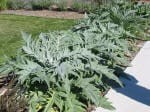 |
Cardoon
page
Cynara cardunculus |
|
 |
Elfin Thyme
a.k.a. creeping thyme
Thymus praecox arcticus
'Elfin'
small
closely spaced leaves and lowers makes it not only one of
the smallest thymes but also one of the slowest growing
thymes. It is a good choice for planting between stepping
stones where spaces may be very small. |
|
| |
'Archer's Gold' Tymus
citriodorus
planted under the cedar tree in the stump patio in 2006
www.Stepables.com |
|
| |
Thyme
thymus cv.
Flower
color: pinkish lavender |
|
|
|
Coconut Thyme
Thymus praecox
arcticus
Low growing
perennial herb with tiny leaves scented like coconut. |
|
 |
Golden Thyme |
|
 |
French Thyme
Narrow green
leaves yield a spicy, sweet flavor. Full Sun. |
|
|
|
German Chamomile
matricaria
recutita
Chamomile
tea is brewed from dried flowers. The flowers may be used
fresh or dried and are best when picked the day they open.
Flowers can be picked for several months. Flower
color white |
|
|
|
|
|
 |
Italian Parsley
petroselenium
crispum cv.
Commonly
used as a garnish, the edible sprig is high in vitamin C,
vitamin A, several B vitamins, calcium and iron. Due to
its high chlorophyll content, it’s a natural breath
freshener. |
|
 |
Spearmint
|
|
 |
Lemon Mint |
|
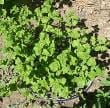 |
Curly Mint
Mentha
aquatica "Crispa'
A
compact-growing mint with a spearmint scent and crispy,
ruffled foliage. Does well in damp shady areas.
Can be grown in pots. Likes Shade. |
|
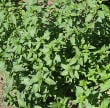 |
Chocolate Mint |
|